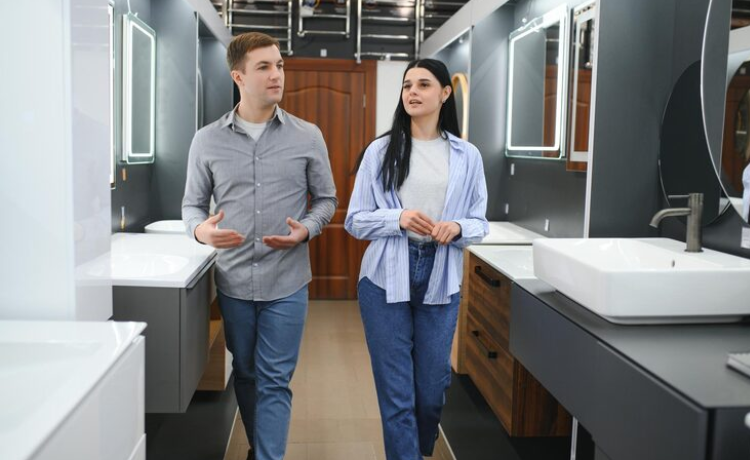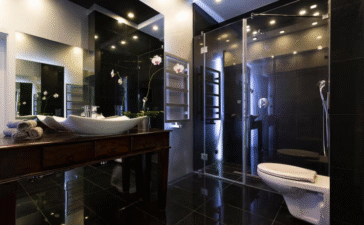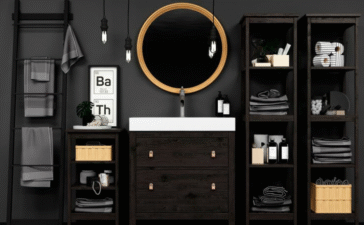Adding a bathroom to your home represents one of the most valuable investments you can make in your property. Whether you’re dealing with morning traffic jams around your single bathroom or planning to increase your home’s resale value, a bathroom addition offers both immediate convenience and long-term financial benefits. The cost to add a bathroom varies dramatically based on numerous factors, from the type of bathroom you choose to its location within your home. Understanding these variables helps you make informed decisions and avoid costly surprises during construction.
This comprehensive guide examines every aspect of bathroom addition costs, providing expert insights into planning, budgeting, and executing your project successfully. We’ll explore different bathroom types, key cost factors, location considerations, and strategies for maximizing your return on investment.
What Is the Cost to Add a Bathroom?
Average Bathroom Addition Costs
The cost to add a bathroom ranges significantly depending on the scope and complexity of your project. A basic half bathroom typically costs between $15,000 and $30,000, while a full bathroom addition can range from $25,000 to $60,000. Master bathroom additions represent the highest investment, often exceeding $80,000 for luxury installations.
Regional differences play a substantial role in determining final costs. Urban areas with higher labor rates and stricter building codes generally command premium prices. For example, bathroom additions in cities like San Francisco or New York can cost 40-60% more than similar projects in smaller metropolitan areas.
Home type also influences pricing structures. Adding a bathroom to a single-story ranch house typically costs less than modifications to multi-story homes or properties with complex architectural features. Older homes may require additional structural work or updated electrical systems, increasing overall expenses.
Factors That Affect Bathroom Addition Costs
Size represents the primary cost driver for bathroom additions. A compact powder room measuring 20-25 square feet requires minimal space and basic fixtures, keeping costs relatively low. Conversely, spacious master bathrooms spanning 100+ square feet demand extensive materials, complex installations, and higher labor investments.
The type of bathroom significantly impacts your budget allocation. Half bathrooms require only toilet and sink installations, making them the most economical option. Three-quarter bathrooms add shower components, while full bathrooms include bathtub installations that require additional plumbing and waterproofing measures.
Location within your home determines the complexity of utility extensions. Adding a bathroom adjacent to existing plumbing lines costs substantially less than installations in remote areas like converted attics or garage spaces. These distant locations often require extensive pipe routing and electrical work, potentially doubling material and labor expenses.
Understanding the Different Types of Bathroom Additions
Half Bathroom (Powder Room)
A half bathroom includes only essential fixtures: a toilet and sink. These compact spaces typically measure 20-25 square feet and serve as convenient guest facilities. Installation costs range from $15,000 to $30,000, making them the most budget-friendly bathroom addition option.
The streamlined fixture requirements reduce both material costs and installation complexity. However, powder rooms still require proper ventilation, adequate lighting, and code-compliant plumbing connections. Many homeowners choose to upgrade finishes in these high-visibility spaces, incorporating premium tiles or designer fixtures.
Three-Quarter Bathroom
Three-quarter bathrooms feature toilet, sink, and shower combinations without bathtub installations. These functional spaces appeal to households prioritizing quick, efficient bathing routines. Typical costs range from $20,000 to $40,000, depending on shower specifications and finish selections.
The absence of bathtub requirements reduces space needs and simplifies plumbing installations. However, shower installations require careful waterproofing and drainage considerations. Walk-in showers with glass enclosures or tile surrounds can significantly impact final costs.
Full Bathroom
Full bathroom installations include all four essential fixtures: toilet, sink, shower, and bathtub. These complete facilities serve family needs while maximizing home value potential. Costs typically range from $25,000 to $60,000, reflecting the complexity of multiple fixture installations.
Bathtub additions require substantial plumbing modifications and structural support considerations. Standard alcove tubs represent economical choices, while freestanding or jetted models command premium pricing. Full bathrooms also demand larger floor plans, increasing tile, flooring, and finishing material requirements.
Master (Primary) Bathroom
Master bathroom additions represent luxury installations featuring premium fixtures, expansive layouts, and high-end finishes. These spaces often include double vanities, separate shower and bathtub areas, and specialized features like heated floors or steam systems. Costs frequently exceed $50,000 and can reach $100,000+ for elaborate installations.
The emphasis on luxury materials drives costs upward significantly. Natural stone countertops, custom cabinetry, and designer fixtures contribute to premium pricing. Master bathrooms also require sophisticated ventilation systems and ample electrical capacity for multiple fixtures and lighting circuits.
Jack and Jill Bathroom
Jack and Jill bathrooms serve two bedrooms through separate entrances while sharing common fixtures. These efficient designs optimize space utilization while providing privacy for multiple users. Installation costs range from $30,000 to $55,000, depending on fixture specifications and finish selections.
The dual-access design requires careful planning to ensure privacy and functionality. Separate vanity areas or compartmentalized layouts help accommodate simultaneous use. Proper ventilation becomes critical due to increased usage patterns and humidity generation.
Wet Room
Wet room designs eliminate traditional shower enclosures, creating open bathing spaces with integrated drainage systems. These contemporary layouts appeal to modern design preferences while offering accessibility benefits. Installation costs range from $25,000 to $50,000, depending on waterproofing requirements and finish selections.
Wet room construction demands extensive waterproofing throughout the entire space. Proper slope calculations ensure efficient drainage while preventing water accumulation. These specialized installations typically require experienced contractors familiar with European-style construction techniques.
Key Cost Factors to Consider When Adding a Bathroom
Size and Layout
Bathroom size directly correlates with material requirements and installation complexity. Larger spaces demand more flooring, wall finishes, and fixtures while requiring additional electrical circuits and plumbing extensions. Complex layouts with multiple fixture areas or architectural features increase labor requirements and project timelines.
Efficient layout planning can minimize costs while maximizing functionality. Standard fixture arrangements reduce plumbing complexity, while creative space utilization can accommodate necessary features within modest square footage. Professional design consultation often proves valuable for optimizing layout efficiency.
Plumbing and Electrical Work
Plumbing installation represents a major cost component for bathroom additions. Extending water supply lines and drainage systems to new locations requires professional expertise and code compliance. Costs range from $3,000 to $10,000 depending on distance from existing utilities and complexity of routing requirements.
Electrical work includes lighting circuits, ventilation fans, GFCI outlets, and specialized fixtures like heated floors or mirrors. Modern bathrooms require substantial electrical capacity to accommodate multiple devices safely. Professional electrical installations typically cost $2,000 to $5,000 for comprehensive bathroom additions.
Materials and Fixtures
Material selections significantly impact overall project costs. Basic ceramic tiles and standard fixtures keep expenses reasonable, while premium materials like natural stone or designer fixtures can double or triple costs. Fixture quality affects both initial expenses and long-term durability considerations.
High-end materials offer superior aesthetics and longevity but require careful budget planning. Many homeowners achieve attractive results by mixing premium accent materials with quality standard options. Strategic splurges on visible elements like countertops or statement tiles maximize visual impact within budget constraints.
Labor Costs
Professional labor represents 40-60% of total bathroom addition costs. Skilled trades including plumbers, electricians, tile installers, and general contractors command varying rates based on regional markets and project complexity. Urban areas typically feature higher labor costs due to increased demand and living expenses.
Quality craftsmanship proves essential for bathroom installations due to moisture exposure and daily use demands. Experienced professionals may charge premium rates but often deliver superior results with comprehensive warranties. Choosing qualified contractors helps avoid costly repairs and ensures code compliance.
Unexpected Expenses
Renovation projects frequently encounter unforeseen complications that increase costs. Structural modifications, utility relocations, or code upgrade requirements can add thousands to project budgets. Older homes particularly face challenges with outdated systems or non-standard construction methods.
Setting aside 15-20% contingency budgets helps manage unexpected expenses without derailing projects. Common surprises include foundation work, HVAC modifications, or permit requirement changes. Thorough pre-construction inspections can identify potential issues before work begins.
How to Choose the Right Location for Your New Bathroom
Best Locations for Adding a Bathroom
Strategic location selection can minimize installation costs while maximizing convenience. Areas adjacent to existing plumbing lines offer the most economical options. Converting existing spaces like large closets, laundry rooms, or unused areas under staircases often provides cost-effective solutions.
Upper floor locations may require structural reinforcement to support fixture loads and water supply pressure. Basement installations offer ample space but may require specialized drainage systems or sewage ejector pumps. Each location presents unique advantages and challenges requiring careful evaluation.
Impact of Location on Costs
Location dramatically affects installation complexity and associated costs. Ground floor additions near existing plumbing can cost 30-50% less than remote installations requiring extensive utility routing. Basement locations may require waterproofing and specialized drainage systems, increasing expenses significantly.
Attic conversions often demand structural modifications, insulation upgrades, and ventilation improvements. Garage conversions may require foundation work and climate control systems. Each location presents specific challenges that experienced contractors can evaluate during planning phases.
Permits and Local Codes
Bathroom additions typically require building permits and inspections to ensure code compliance. Permit costs range from $200 to $2,000 depending on project scope and local requirements. Some jurisdictions mandate licensed contractor installations, while others allow qualified homeowner work with proper permits.
Code requirements address structural integrity, plumbing standards, electrical safety, and ventilation adequacy. Non-compliance can result in costly corrections or legal complications during home sales. Professional contractors maintain current knowledge of local codes and permit requirements.
Return on Investment (ROI) from Adding a Bathroom
Does Adding a Bathroom Increase Home Value?
Bathroom additions consistently rank among the highest value home improvements. Adding a full bathroom typically recovers 60-80% of investment costs upon resale, while powder rooms often achieve 50-70% recovery rates. Homes with insufficient bathroom facilities gain disproportionately from additions.
Market conditions and local preferences influence actual returns. Areas with strong real estate markets or limited housing inventory often see higher returns on bathroom investments. The number of existing bathrooms also affects value potential, with single-bathroom homes benefiting most from additions.
Key Considerations for Maximizing ROI
Strategic planning maximizes return potential from bathroom additions. Focus on functionality over luxury features unless your home’s price range supports premium installations. Quality materials and professional installation ensure lasting value and buyer appeal during future sales.
Consider neighborhood standards when planning bathroom additions. Modest homes in affordable neighborhoods benefit from practical additions, while luxury properties may justify premium features and finishes. Market research helps align investment levels with realistic return expectations.
How Adding a Bathroom Affects Resale Value
Additional bathrooms enhance home marketability by expanding potential buyer pools. Families with children particularly value multiple bathroom access, while aging populations appreciate main-floor bathroom convenience. Modern buyers expect adequate bathroom facilities relative to home size and bedroom count.
The bathroom-to-bedroom ratio significantly influences buyer perceptions. Homes with one bathroom per two bedrooms generally meet market expectations, while ratios below this standard may discourage potential buyers. Strategic bathroom additions can correct these imbalances effectively.
Expert Tips for Planning Your Bathroom Addition
Planning Your Budget
Successful bathroom addition projects begin with realistic budget planning. Research local contractor rates and material costs to establish baseline expectations. Include permits, professional fees, and contingency funds in initial budgets to avoid financial surprises during construction.
Prioritize essential features over luxury amenities when budget constraints exist. Focus spending on quality fixtures and professional installation rather than premium finishes that can be upgraded later. Phased renovation approaches allow homeowners to spread costs over extended periods while achieving immediate functionality improvements.
Working with Contractors
Selecting qualified contractors ensures professional results and code compliance. Request references from recent bathroom projects and verify licensing and insurance coverage. Multiple estimates help establish fair pricing while revealing different approaches to your project requirements.
Communication proves critical throughout renovation projects. Establish clear timelines, material specifications, and change order procedures before work begins. Regular progress meetings help identify potential issues early while maintaining project momentum toward completion.
Eco-Friendly Bathroom Renovations
Sustainable bathroom features reduce environmental impact while potentially lowering utility costs. Low-flow fixtures, LED lighting, and efficient ventilation systems offer long-term savings. Many eco-friendly products now match traditional options in performance and aesthetics.
Green building materials like bamboo flooring, recycled glass tiles, and low-VOC paints create healthier indoor environments. Some jurisdictions offer rebates or tax incentives for water-saving fixtures or energy-efficient installations. Research available programs before finalizing material selections.
Common Mistakes to Avoid
Inadequate planning represents the most frequent bathroom addition mistake. Rushing into construction without proper permits, professional consultations, or detailed plans often results in costly corrections. Take time for thorough planning to avoid expensive change orders during construction.
Underestimating costs leads to budget overruns and incomplete projects. Include all professional fees, permits, and contingency funds in initial budgets. Cheap materials or inexperienced contractors may initially seem economical but often require costly repairs or replacements within a few years.
You shoould also check: “black stone hexagon tile bathroom“
Maximizing Your Bathroom Addition Investment
Successfully adding a bathroom to your home requires careful planning, realistic budgeting, and professional execution. Understanding the various cost factors helps you make informed decisions that balance functionality, aesthetics, and financial considerations.
The investment in a bathroom addition extends beyond immediate convenience to enhance your property’s long-term value and marketability. Whether you choose a practical powder room or luxurious master suite, professional planning and quality construction ensure lasting satisfaction with your investment.
Take time to research local contractors, obtain multiple estimates, and secure proper permits before beginning your project. The additional effort invested in planning pays dividends through smoother construction processes and superior finished results that serve your family for years to come.
Frequently Asked Questions
What is the cheapest bathroom to add?
A half bathroom or powder room represents the most economical bathroom addition option. These compact spaces require only toilet and sink installations, typically costing between $15,000 and $25,000. Converting existing space like large closets near plumbing lines can further reduce costs compared to constructing entirely new areas.
How long does it take to add a bathroom to a home?
Bathroom addition timelines vary from 2-8 weeks depending on project complexity and scope. Simple powder room installations in existing spaces may complete within 2-3 weeks, while full bathroom additions requiring extensive plumbing and electrical work typically require 4-6 weeks. Master bathroom additions with luxury features can extend beyond 8 weeks for completion.
Can I add a bathroom without permits?
Most jurisdictions require building permits for bathroom additions involving plumbing, electrical, or structural modifications. Attempting unpermitted work can result in code violations, safety hazards, and complications during home sales. Contact your local building department to understand specific permit requirements before beginning any bathroom addition project.
How can I save money when adding a bathroom?
Several strategies can reduce bathroom addition costs without compromising quality. Choose locations near existing plumbing to minimize utility extensions. Select standard fixtures over premium models, and consider doing preparatory work like demolition yourself. Purchasing materials during sales or choosing contractor-grade products over designer brands also provides meaningful savings.
Does adding a bathroom always increase home value?
While bathroom additions typically increase home value, the actual return depends on various factors including local market conditions, existing bathroom count, and installation quality. Homes with inadequate bathroom facilities see the greatest value increases, while properties with sufficient bathrooms may experience diminished returns from additional installations.
What’s the difference between a three-quarter and full bathroom?
A three-quarter bathroom includes toilet, sink, and shower but lacks a bathtub. Full bathrooms contain all four fixtures: toilet, sink, shower, and bathtub. Three-quarter bathrooms cost less to install and require less space, making them popular choices for secondary bathrooms or homes where quick showers are preferred over bathing.











